
<<back || index
|| next>>
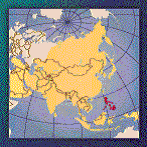
The Philippines
The Philippines
GEOGRAPHY
- Southeastern Asia, archipelago between the Philippine
Sea and the South China Sea, east of Vietnam
- Geographic Coordinates:13 00 N, 122 00 E
- Area: total: 300,000 sq. km (land: 298,170
sq. km; water: 1,830 sq. km)
(CIA: The World Factbook 2001: http://www.cia.gov/cia/publications/factbook/index.html)
- Having problems linking
all of its islands together into one grid and ensuring
availability of electric power to the remaining
9,708 villages without electricity.
(EIA: http://www.eia.doe.gov/cabs/philippi.html)
GEODYNAMICS
- Major mature volcanic arc, formed from long-lasting
subduction of Philippines Sea plate below Eurasian
plate
- Mindinao
- Southernmost island of the Philippines
- West-vergent subduction of the Pacific plate
below the Philippine Sea plate
- East-vergent subduction of the Indochina shelf
below the Philippine arc
- Mariana
- Classic example of an immature island arc
- Subduction of Pacific plate below Philippine
Sea plate
(Acadia University: http://ace.acadiau.ca/science/geol/rraeside/quizzes/world-notes.htm)
|
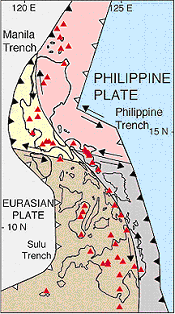
|
The plate
tectonics in the Philippines is complex
and includes plate boundaries that are changing
rapidly. Several micro-plates are getting squeezed
between two convergent plate margins. Stratigraphic
evidence indicates cessation and reactivation
of subduction at some trenches. The currently
active volcanoes in the Philippines define two
north-south trending arcs. The scale and type
of volcanism varies from monogenetic cinder
cone fields to large stratovolcanoes and calderas.
Composition of volcanic rocks range from tholeiitic
basalt to andesite to shoshonite.
- Black triangles = active subduction zones
with "teeth" on the over-riding plate,
- White triangles = inactive subduction zones
with "teeth" on the over-riding plate,
- Arrows = transform or major strike-slip
faults,
- Red triangles = volcanoes active in the
last 10,000 years. Plates and micro-plates
shown in different colors.
Based on Divis (1983). Volcanoes from Simkin
and Siebert (1994).
|
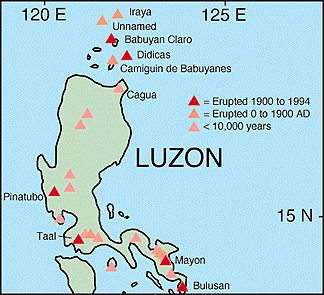 In
the west, more steeply east-dipping subduction of
the Eurasian Plate (South China Sea basing and the
transitional oceanic-continental crust of the Palawan
block) along the 560 mile (900 km) length of the Manila
and Sulu trenches produces a discontinuous line of
active volcanoes from Taal in the south to Iraya in
the north. Volcanism associated with this subduction
zone began about 10 million years ago. In
the west, more steeply east-dipping subduction of
the Eurasian Plate (South China Sea basing and the
transitional oceanic-continental crust of the Palawan
block) along the 560 mile (900 km) length of the Manila
and Sulu trenches produces a discontinuous line of
active volcanoes from Taal in the south to Iraya in
the north. Volcanism associated with this subduction
zone began about 10 million years ago.
(University of North Dakota, http://volcano.und.nodak.edu/vwdocs/volc_images/southeast_asia/philippines/Phivolcn.gif)
In the east, shallow west-dipping subduction of the
Philippine Plate at the Philippine Trench produces
a line of volcanoes from Balut in the south to Mayon
in the north Based on Divis (1983).
Volcanoes in the east-west zone across central Luzon
may be associated with a "leaky" transform
fault that connects the two subducion zones. The transform
fault is offset to the right by the younger Philippines
Fault. Based on Divis (1983).
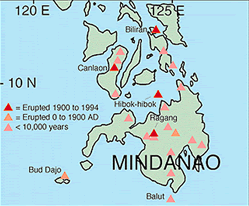 The
volcanoes of the Philippines are the most deadly and
costly in the world. Fatalities have been caused by
13% of the historic eruptions, most notably at Taal
and Mayon, and 22% of the eruptions caused damage.
Mudflows are more common in the Philippines, compared
to other regions, because of heavy rains. Tsunami
are more commonly associated with eruptions at the
Philippines than in any other volcanic region. Many
of the Holocene volcanoes in the Philippines have
eruptive products that have not been dated. Since
the Philippines Institute of Volcanology and Seismology
has been established the impacts of eruptions have
been greatly reduced. The
volcanoes of the Philippines are the most deadly and
costly in the world. Fatalities have been caused by
13% of the historic eruptions, most notably at Taal
and Mayon, and 22% of the eruptions caused damage.
Mudflows are more common in the Philippines, compared
to other regions, because of heavy rains. Tsunami
are more commonly associated with eruptions at the
Philippines than in any other volcanic region. Many
of the Holocene volcanoes in the Philippines have
eruptive products that have not been dated. Since
the Philippines Institute of Volcanology and Seismology
has been established the impacts of eruptions have
been greatly reduced.
(University of North Dakota: http://volcano.und.nodak.edu/vwdocs/volc_images/southeast_asia/philippines/tectonics.html)
ELECTRICITY
- Electric Generation Capacity (1999E): 12 million
kilowatts
- Electricity Generation (2000E): 40.7 billion kilowatthours
(bkwh)
- Thermal: 57.5%, Hydro: 19.9%, Renewable: 22.6%*)
- Electricity Consumption (2000E): 37.8 bkwh
- Power Industry Reform Act
(2001)
- To develop indigenous
resources
- To cut the high cost
of power
- To encourage foreign
investment.
- Separate local systems are
being established to meet economical needs
* The total energy consumption
statistic includes petroleum, dry natural gas,
coal, net hydro, nuclear, geothermal, solar
and wind electric power. The renewable energy
consumption statistic is based on EIA data and
includes geothermal, solar, wind, wood and waste
electric power consumption.. Sectoral shares
of energy consumption and carbon emissions are
also based on IEA data.
(EIA: http://www.eia.doe.gov/emeu/cabs/philippi.html)
GEOTHERMAL
ELECTRICITY GENERATION
Installed geothermal generating
capacity (2000) in MW
|
|
Tiwi
|
330
|
|
Makban
|
425.73
|
|
Tongonan
|
707.75
|
|
Palinpinon
|
195.5
|
|
Bacman
|
150
|
|
Mindanao
|
100
|
|
Total
|
1908.98
|
(IGA: http://iga.igg.cnr.it/philippines.php)
- The world's second largest producer of geothermally-generated
electricity, with an available capacity of 1931MW
(2001)
- Geothermal power accounts for the country's
largest share of indigenous energy production
(16% of the total installed generation capacity),
followed by hydropower, coal, oil and gas
- With foreign investment and cooperation, projects
of additional geothermal energy facilities are
underway.
(EIA: http://www.eia.doe.gov/cabs/philippi.html)
- An agreement over geothermal development was
singed between the Philippines and Indonesia in
November 2001.
(www.gov.ph: www.gov.ph/news/default.asp?newsid=177)
PLANNED CAPACITY
Planned capacity additions
in the Philippines
|
Project
|
Planned capacity additions
(MWe)
|
Year
|
|
Northern Negros
|
<>
|
2002
|
|
Montelago
|
16
|
2002
|
|
Mt. Cabalian
|
110
|
2006
|
|
Amacan
|
40
|
2007
|
|
Mt. Labo
|
20
|
2007
|
|
Batong-Buhay
|
120
|
2007
|
|
Buguias-Tinoc
|
120
|
2007
|
|
Bato Lunas
|
60
|
2008
|
|
Planned total
|
526
|
|
(IGA: http://iga.igg.cnr.it/philippines.php)
GEOTHERMAL POTENTIAL
Geothermal energy resources have been initially assessed
in forty (40) sites to have an aggregate potential
capacity between 2,365 MW and 3,705 MW. Of these potentials,
1,194 MW is ready being utilized and 900 MW is presently
being developed. About 270 to 1,600 MW is estimated
to available for future development.
Geothermal Resource Potential
|
Location
|
Status
|
No. of Sites
|
Low Potential
|
High Potential
|
Capacity
|
Energy
|
Capacity
|
Energy
|
|
|
|
|
MW
|
%
|
GWh
|
%
|
MW
|
%
|
GWh
|
%
|
|
Luzon
|
Producing
|
3
|
890
|
67
|
5457
|
67
|
1080
|
53
|
6623
|
53
|
|
|
Develop. Stage
|
1
|
30
|
2
|
184
|
2
|
30
|
2
|
184
|
2
|
|
|
Adv. Exp.Stage
|
6
|
180
|
14
|
1104
|
14
|
440
|
22
|
2698
|
22
|
|
|
Prelim Exp. Stage
|
11
|
220
|
17
|
1349
|
17
|
450
|
23
|
2759
|
23
|
|
|
Total
|
21
|
1320
|
100
|
8094
|
100
|
2000
|
100
|
12264
|
100
|
|
|
|
|
|
|
|
|
|
Vsayas
|
Producing
|
2
|
730
|
82
|
4476
|
82
|
980
|
74
|
6009
|
74
|
|
|
Develop. Stage
|
|
-
|
-
|
-
|
-
|
-
|
-
|
-
|
-
|
|
|
Adv. Exp.Stage
|
5
|
145
|
16
|
889
|
16
|
250
|
19
|
1533
|
19
|
|
|
Prelim Exp. Stage
|
5
|
20
|
2
|
123
|
2
|
95
|
7
|
583
|
7
|
|
|
Total
|
12
|
895
|
100
|
5488
|
100
|
1325
|
100
|
8125
|
100
|
|
|
|
|
|
|
|
|
|
Location
|
Status
|
No. of Sites
|
Low Potential
|
High Potential
|
|
|
|
|
Capacity
|
Energy
|
Capacity
|
Energy
|
|
Mindanao
|
Producing
|
|
-
|
-
|
-
|
-
|
-
|
-
|
-
|
-
|
|
|
Develop. Stage
|
1
|
120
|
80
|
736
|
80
|
240
|
63
|
1472
|
63
|
|
|
Adv. Exp.Stage
|
1
|
10
|
7
|
61
|
7
|
20
|
5
|
123
|
5
|
|
|
Prelim Exp. Stage
|
5
|
20
|
13
|
123
|
13
|
120
|
32
|
736
|
32
|
|
|
Total
|
7
|
150
|
100
|
920
|
100
|
380
|
100
|
2330
|
100
|
|
|
|
|
|
|
|
|
|
Philippines
|
Producing
|
5
|
1620
|
68
|
9934
|
68
|
2060
|
56
|
12632
|
56
|
|
|
Develop. Stage
|
2
|
150
|
6
|
920
|
6
|
270
|
7
|
1656
|
7
|
|
|
Adv. Exp.Stage
|
12
|
335
|
14
|
2054
|
14
|
710
|
19
|
4354
|
19
|
|
|
Prelim Exp. Stage
|
21
|
260
|
11
|
1594
|
11
|
665
|
18
|
4078
|
18
|
|
|
Total
|
40
|
2365
|
100
|
14502
|
100
|
3705
|
100
|
22719
|
100
|
Source/quotation: 1996 Power Development
Program (1996-2005),
National Power Corporation Diliman (NPC), Quezon City.
Luzon&Vis/Min Systems Planning Departments, Corporate
Planning Group, September 1995.
(EM: http://www.gtz.de/em-home/phil/emphil22.htm)
CONSIDERATIONS
WORLD HERITAGE
- Tubbataha Reef Marine Park
- Puerto-Princesa Subterranean River NP
(UNESCO: http://whc.unesco.org/sites/natural.htm)
NATIONAL PARKS AND RESERVES
VULNERABLE/ENDANGERED ECOREGIONS
- Greater Negros-Panay rain forests (IM0114)
- Luzon montane rain forests (IM0122)
- Mindanao montane rain forests (IM0128)
- Mindanao-Eastern Visayas rain forests (IM0129)
- Mindoro rain forests (IM0130)
- Palawan rain forests (IM0143)
- South China Sea Islands (IM0148)
- Sulu Archipelago rain forests (IM0156)
- Luzon tropical pine forests (IM0302)
(WWF: http://www.worldwildlife.org/wildworld/profiles/terrestrial_im.html)
GEOGRAPHIC
LOCATION OF ECOREGIONS
(National Geographic:
http://www.nationalgeographic.com/wildworld/terrestrial.html?id=1&mapServiceName=WW_Terrecos
&locWidth=120&locHeight=72&cMinx=141.8004&cMiny=45.914108&cMaxx=142.666901&cMaxy=47.798401&size=small
&detail=detailed?id=1&size=small&detail=detailed&cMinx=142.23&cMiny=41&cMaxx=185.4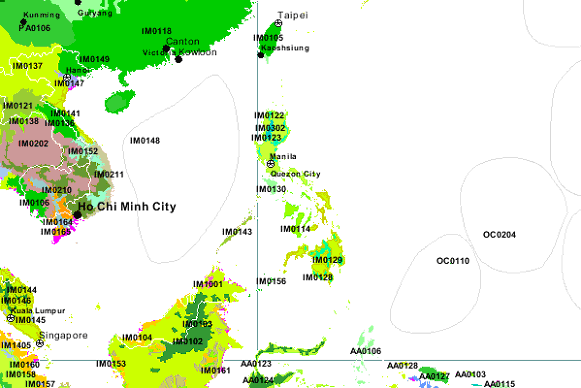 3&cMaxy=69.13) 3&cMaxy=69.13)
POPULATION DISTRIBUTION
Population Distribution by Region:
2000
|
Region
|
Population
|
Percent
|
|
Philippines
|
76,504,077
|
100.00
|
|
NCR
|
9,932,560
|
12.98
|
|
CAR
|
1,365,412
|
1.78
|
|
Region I –
Ilocos
|
4,200,478
|
5.49
|
|
Region II –
Cagayan
|
2,813,159
|
3.68
|
|
Region III
– Central Luzon
|
8,030,945
|
10.50
|
|
Region IV –
Southern Tagalog
|
11,793,655
|
15.42
|
|
Region V –
Bicol
|
4,686,669
|
6.13
|
|
Region VI –
Western Visayas
|
6,211,038
|
8.12
|
|
Region VII
– Central Visayas
|
5,706,953
|
7.46
|
|
Region VIII
– Eastern Visayas
|
3,610,355
|
4.72
|
|
Region IX –
Western Mindanao
|
3,091,208
|
4.04
|
|
Region X –
Northern Mindanao
|
2,747,585
|
3.59
|
|
Region XI –
Southern Mindanao
|
5,189,335
|
6.78
|
|
Region XII
– Central Mindanao
|
2,598,210
|
3.40
|
|
ARMM
|
2,412,159
|
3.15
|
|
Caraga
|
2,095,367
|
2.74
|
(NSO: http://www.census.gov.ph/data/pressrelease/2002/pr02178tx.html)
References
- Acadia University. Significant places for global tectonics. Retrieved from world wide web:
http://ace.acadiau.ca/science/geol/rraeside/quizzes/world-notes.htm (November 24, 2002)
- Central Intelligence Agency (CIA). (January 2002).
The world factbook 2002 – the Philippines. Retrieved
from world wide web : http://www.cia.gov/cia/publications/factbook/geos/rp.html
(September 10, 2002)
- Endangered Endemic Species of the Philippines.(
September 1999). Retrieved from world wide web:
http://www.geocities.com/RainForest/Vines/4625/main.html
(November 2, 2002)
- Energy Information Administration (EIA). (May
2002). Country analysis briefs – the Philippines.
Retrieved from world wide web: http://www.eia.doe.gov/cabs/philippi.html
(November 2, 2002)
- Environment Manual for Power Development (EM).
Geothermal resource potential – the Philippines.
Retrieved from world wide web: http://www.gtz.de/em-home/phil/emphil22.htm
(September 10, 2002)
- Food and Agriculture Organization
of the United Nations (FAO), Aquaculture feed and
fertilizer resource atlas of the Philippines – Population
and population density by region. Retrieved from
world wide web: http://www.fao.org/DOCREP/003/W6928E/w6928e0c.htm#Table%202.%20Population%20and%20population%20density%20by%20region
(December 12, 2002)
- Geothermal Education Office (GEO). (October 1997).
The Philippines. Retrieved from world wide web :
http://www.geothermal.marin.org/map/phil.html
(September 10, 2002)
- Government of the Philippines. (2002). www.gov.ph.
GMA, Megawati witness signing of gov'tto-gov't,
private sector accords. Retrieved from world wide
web: http://www.gov.ph/news/default.asp?newsid=177
(November 2,2002)
- International Geothermal Association (IGA). (May
2002). Welcome to our page with data for Philippines.
Retrieved from world wide web: http://iga.igg.cnr.it/philippines.php
(November 2, 2002)
- National Geographic. Wild world – Terrestrial
ecoregions of the world. Retrieved from world wide
web:
http://www.nationalgeographic.com/wildworld/terrestrial.html?id=1&mapServiceName=WW_Terrecos&locWidth=120
&locHeight=72&cMinx=141.8004&cMiny=45.914108&cMaxx=142.666901&cMaxy=47.798401&size=small
&detail=detailed?id=1&size=small&detail=detailed&cMinx=142.23&cMiny=41&cMaxx=185.43&cMaxy=69.13
(October 20, 2002)
- National Statistical Coordination Bord (NSCB).
(June 2002). Population Distribution. Retrieved
from world wide web : http://www.nscb.gov.ph/activestats/psgc/listcity2.asp
(by city), http://www.nscb.gov.ph/activestats/psgc/listprov.asp
(by province) (November 2, 2002)
- National Statistics Office, Republic of the Philippines
(NSO). (October 16, 2002). Philippines: Population
expected to reach 100 million filipinos in 14 years
– Population distribution by region :2000.
Retrieved from world wide web: http://www.census.gov.ph/data/pressrelease/2002/pr02178tx.html
(December 27, 2002)
- United Nation Educational, Scientific, and Cultural
Organization (UNESCO). (July 1, 2002). Natural properties
on the world heritage list. Retrieved from world
wide web: http://whc.unesco.org/sites/natural.htm
(November 24, 2002)
- University of North Dakota. Tectonics and Volcanoes
of the Philippines, Retrieved from world wide web:
http://volcano.und.nodak.edu/vwdocs/volc_images/southeast_asia/philippines/tectonics.html>
(October 5, 2002)
- World Wildlife Funds (WWF). Ecoregions. Retrieved
from world wide web: http://www.worldwildlife.org/wildworld/profiles/terrestrial_im.html
(November 24, 2002)
<<back || index
|| next>>

|



 In
the west, more steeply east-dipping subduction of
the Eurasian Plate (South China Sea basing and the
transitional oceanic-continental crust of the Palawan
block) along the 560 mile (900 km) length of the Manila
and Sulu trenches produces a discontinuous line of
active volcanoes from Taal in the south to Iraya in
the north. Volcanism associated with this subduction
zone began about 10 million years ago.
In
the west, more steeply east-dipping subduction of
the Eurasian Plate (South China Sea basing and the
transitional oceanic-continental crust of the Palawan
block) along the 560 mile (900 km) length of the Manila
and Sulu trenches produces a discontinuous line of
active volcanoes from Taal in the south to Iraya in
the north. Volcanism associated with this subduction
zone began about 10 million years ago.  The
volcanoes of the Philippines are the most deadly and
costly in the world. Fatalities have been caused by
13% of the historic eruptions, most notably at Taal
and Mayon, and 22% of the eruptions caused damage.
Mudflows are more common in the Philippines, compared
to other regions, because of heavy rains. Tsunami
are more commonly associated with eruptions at the
Philippines than in any other volcanic region. Many
of the Holocene volcanoes in the Philippines have
eruptive products that have not been dated. Since
the Philippines Institute of Volcanology and Seismology
has been established the impacts of eruptions have
been greatly reduced.
The
volcanoes of the Philippines are the most deadly and
costly in the world. Fatalities have been caused by
13% of the historic eruptions, most notably at Taal
and Mayon, and 22% of the eruptions caused damage.
Mudflows are more common in the Philippines, compared
to other regions, because of heavy rains. Tsunami
are more commonly associated with eruptions at the
Philippines than in any other volcanic region. Many
of the Holocene volcanoes in the Philippines have
eruptive products that have not been dated. Since
the Philippines Institute of Volcanology and Seismology
has been established the impacts of eruptions have
been greatly reduced.